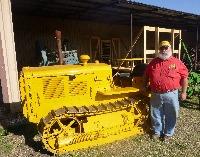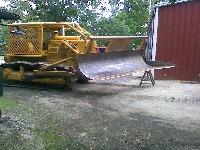- Posts: 7
- Thank you received: 6

ACMOC Membership Benefits
- FREE quarterly magazine filled with content about antique Caterpillar machines
- FREE classified listings
- ACMOC store discounts and specials
- Full Bulletin Board Access
- Marketplace (For Sale/Wanted)
- Technical Library
- Post attachments
$44 /year ELECTRONIC
$60 /year USA
$77 /year International
Repairing governor flange
- Dirtbiker1824
-
 Topic Author
Topic Author
- Offline
- New Boarder
- User
Attachments:
Please Log in or Create an account to join the conversation.
Regards,
Tony
Please Log in or Create an account to join the conversation.
Please Log in or Create an account to join the conversation.
- trainzkid88
-

- Offline
- Platinum Boarder
- Member
- Posts: 1017
- Thank you received: 387
grind and file the weld so its only just proud of the surface and hose no sharp edges it should last for decades.
the preheat helps prevent cracking and also help dry and pull impurities from the metal. the slow cooling prevent post cracking.
you can use flux coated or plain rods with flux flux coated are easier to work with available in a handy pack for those small jobs
Please Log in or Create an account to join the conversation.
- Shaban1983
-

- Offline
- Junior Boarder
- User
- Posts: 25
- Thank you received: 24
Or use bronze brazing.
Arc welds in cast iron do tend to crack
Please Log in or Create an account to join the conversation.
Please Log in or Create an account to join the conversation.
Please Log in or Create an account to join the conversation.
Please Log in or Create an account to join the conversation.
- NickyWalnuts
-

- Offline
- Senior Boarder
- Member
- Posts: 48
- Thank you received: 27
Please Log in or Create an account to join the conversation.
- NickyWalnuts
-

- Offline
- Senior Boarder
- Member
- Posts: 48
- Thank you received: 27
If it’s cast steel, same concept with the needle scaler to disguise your repair.
Good luck.
Please Log in or Create an account to join the conversation.
ACMOC
Antique Caterpillar Machinery Owners Club
P.O. Box 9301
Peoria, IL 61612
(309) 691-5002
cat@acmoc.org
"I became a member recently because the wealth of knowledge here is priceless."
- Chris R
"I also joined a year ago. had been on here a couple of times as a non-member and found the info very helpful so I got a one year subscription (not very expensive at all) to try it out. I really like all the resources on here so I just got a three year. I think its a very small price for what you can get out of this site."
- Jason N



